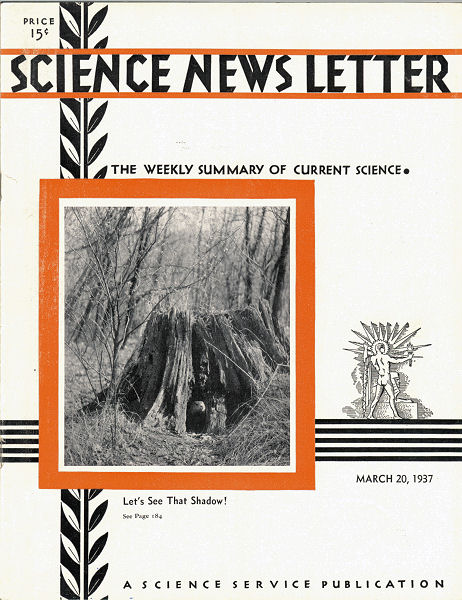From the March 20, 1937, issue

GROUNDHOG WILL SOON SEE THAT MUCH-DEBATED SHADOW
Candlemas Day is a good month too early for any groundhog to come out and look for his shadow. These rodents are very determined sleepers, and have never been known to break their winter sleep, in the southern part of their range, until about the first of March. Farther north, they sleep longer still, and may not appear until nearly May. In any case, the groundhog may be depended upon to wait until winter is surely over before he emerges; no silly business of sticking his nose out into early-February cold waves for him!
The picture on the cover of this issue of the Science News Letter also demonstrates convincingly the sound observational common sense that underlies the groundhog’s other name of woodchuck.
MICROFILMS HAILED AS NEW WAY TO DUPLICATE BOOKS, PICTURES
A new way of duplicating records, manuscripts, books, and illustrations is being developed, and scientists predict that it is destined to play a large part in the scholarly research of the future.
It consists of making miniature photographs on film and then reading them by use of a machine that enlarges them to more than original size on a translucent screen.
“Microfilms,” these small photographs of documents and books are called. Soon, it is predicted, this word will be as common as ‘book” or “journal” in library, educational, and scientific circles.
These microfilms are made on ordinary motion picture film. A hundred feet of microfilm, small enough to slip into the vest pocket, will hold 1,600 pages of a book or manuscript, or more than the contents of five ordinary fat books.
Science Service, the institution for the popularization of science, has inaugurated and sponsored this development with the cooperation of the Chemical Foundation, the U.S. Naval Medical School, the U.S. Department of Agriculture Library, the U.S. Bureau of the Census, the Library of Congress, the Works Progress Administration, and other agencies.
This new technique is called “microphotography,” not to be confused with “photomicrography,” which is the making of large photographs of very small objects through a microscope.
BACTERIA, MOLDS, AND YEASTS PROMISE FARM PROBLEMS SOLUTION
Bacteria, molds, and yeasts, more noted now as disease-bringers and spoilers of things than for their useful activities, were hailed as potential factors in the solution of America’s agricultural problems by Prof. Ellis I. Fulmer of Iowa State College, speaking before the Midwestern Conference of Agriculture, Industry and Science.
Farming, Prof. Fulmer pointed out, is essentially a chemical-manufacturing process. The farmer is foreman in a chemical factory, wherein his crop plants are living machines using the energy of sunlight to make carbohydrates, fats, and proteins out of raw materials from air and earth. In the process, energy is woven into the things that come out as end-products.
Formerly, the farmer cashed in on the release of a large part of that stored energy by feeding crop products to his work animals. Now, he uses tractors and power machinery instead of horses and mules. So, the products pile up, creating economic crises that can be only temporarily solved by crop-limitation methods.
A considerable part of the answer can be found, Prof. Fulmer pointed out, in turning over the job of digesting carbohydrates (starches and sugars) to bacteria, molds, and yeasts. These use up part of the energy in their life processes, but they turn back to the chemical industrialist a great variety of liquid fuels, solvents, ingredients for explosives, etc. Prof. Fulmer displayed a list of more than 40 products that can be obtained from the microorganic fermentation of carbohydrates, only a few of which have present economic uses.







